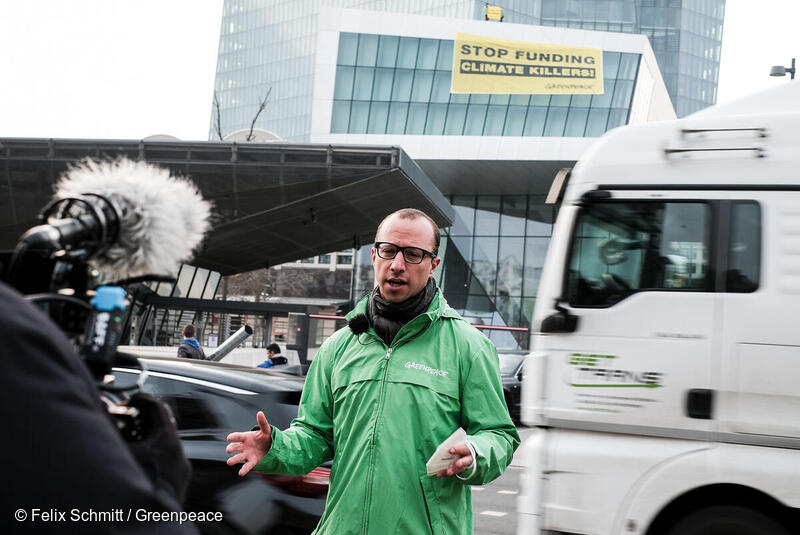New research reveals €300 billion in climate-killing loan collaterals
PHOTOS AND VIDEO AVAILABLE HERE

Brussels/Frankfurt – Activists on paragliders landed on the headquarters of the European Central Bank (ECB) in Frankfurt on Wednesday, on the eve of a meeting of the ECB’s governing board, to protest its climate-killing monetary policy.
The protest comes in the wake of a new report revealing how the rules governing which assets private banks can provide to the ECB as collateral when borrowing money favour fossil fuel companies. As a result, the ECB has backed assets worth some €300 billion, benefiting over 60 companies, including Shell, Total, Eni, OMV and Repsol.
Two Greenpeace Germany activists landed on the roof of the ECB building, and displayed a twelve by six-metre banner reading: “Stop funding climate killers!” Another paraglider circled the building with a fluttering banner reading: “Act on climate now.” *
The report, “Greening the Eurosystem Collateral Framework” is jointly published by the New Economics Foundation (NEF), SOAS University of London, the University of the West of England, the University of Greenwich and Greenpeace Central and Eastern Europe.
Greenpeace International executive director Jennifer Morgan said: “Carbon bias is rife at the European Central Bank. Instead of favouring fossil fuels, the ECB must at once exclude these toxic assets and change the rules to tackle the climate emergency we live in. A green and just transition to a resilient carbon-free world must be front and centre for the ECB.”
The higher exposure of carbon-intensive sectors to climate policy measures, and the impact of climate breakdown, is not reflected in the value the ECB attributes to assets (a markdown on the asset price, known as a haircut) for highly polluting activities, implicitly favouring them when they are offered to secure a loan. At the same time, they dominate the list of assets that the ECB accepts as collateral: while they make up 59% of eligible corporate bonds in the ECB collateral framework, the fossil fuels sector, energy-intensive industry, carbon-intensive transportation, and non-renewable utilities sectors only contribute 24% of corporate employment and 29% to gross value added, the report finds.
The analysis offers three alternative scenarios that the ECB could adopt to support the transition to renewable energy and to tackle the climate emergency, helping it align with the Paris climate agreement. In the first “climate aligned haircuts” scenario, the ECB could adjust the haircuts of bonds based on the climate footprint of the underlying company, which reduces the amount that banks can receive in loans when providing the bonds of polluting companies as collateral. In the second “lower-carbon, climate aligned haircuts” scenario, in addition to climate-aligned haircuts, the ECB would exclude bonds linked to fossil fuels. In the “low carbon scenario, climate-aligned haircuts” scenario, the ECB would exclude the vast majority of bonds issued by carbon-intensive sectors, leading to a reduction of over 70% in the carbon intensity of corporate bonds in the collateral framework.
The publication of the report comes one day ahead of the ECB’s governing council monetary policy meeting.
CEO of the New Economics Foundation Miatta Fahnbulleh said: “Different members of the Euro system have recognised the dirty little secret in the rules governing the ECB’s collateral framework, but they have suggested that it could optimistically take 3 to 5 years to green these operations. Unfortunately, the climate crisis is not going anywhere – we can’t afford to wait for transformative action. With this new report, we have a plan that will enable the ECB to go further and faster, by genuinely leading by example on greening its own operations and the wider financial system.”
Daniela Gabor, Professor of Economics and Macrofinance, University of the West of England (UWE) Bristol, said: “The ECB has recognized that it needs to tackle the carbon bias hardwired into monetary policy. We show that it can easily green its collateral rules, by no longer lending to banks against dirty bond collateral, and by climate-aligning its lending terms (haircuts)”.
ends
* This press release was amended on 10 March 2021 to specify that two activists were on the roof of the ECB, while one other circled the building in a paraglider. A total of 10 activists were involved in the protest.
Contacts:
Adam Pawloff – Greenpeace Central and Eastern Europe climate and energy campaigner: +43 650 3722524, [email protected]
Mihaela Bogeljić – Greenpeace Central and Eastern Europe communications: +385 92 2929 265, [email protected]
For breaking news and comment on EU affairs: www.twitter.com/GreenpeaceEU
Greenpeace is an independent global campaigning organisation that acts to change attitudes and behaviour, to protect and conserve the environment and to promote peace. We do not accept donations from governments, the EU, businesses or political parties. We have over three million supporters, and offices in more than 55 countries.



